Taxation Law Assignment: Land Sale, Deductions, and Income
VerifiedAdded on 2021/06/17
|5
|1460
|81
Homework Assignment
AI Summary
This taxation law assignment delves into the intricacies of determining assessable income from the sale of land, disregarding capital gains. The solution analyzes whether the transaction constitutes an isolated one and thus generates ordinary income, referencing relevant case laws like Casimaty v FC of T and FCT v Whitfords Beach Pty Ltd. It also applies the principles of FCT v Myer Emporium Ltd to assess the commercial nature, profit intention, and business-like conduct of the land sale. Furthermore, the assignment examines the tax treatment of various expenses, including nanny expenses, transport costs, suit costs, airfare, seminar costs, manager's salary, ceiling repairs, painting of walls, and losses from avocado sales, referencing relevant sections of the ITAA 1997 and associated case law to determine their deductibility. The solution provides a comprehensive analysis of each expense, determining whether it is deductible or non-deductible based on its connection to assessable income generation and whether it falls within the negative limb of personal or domestic expenses.
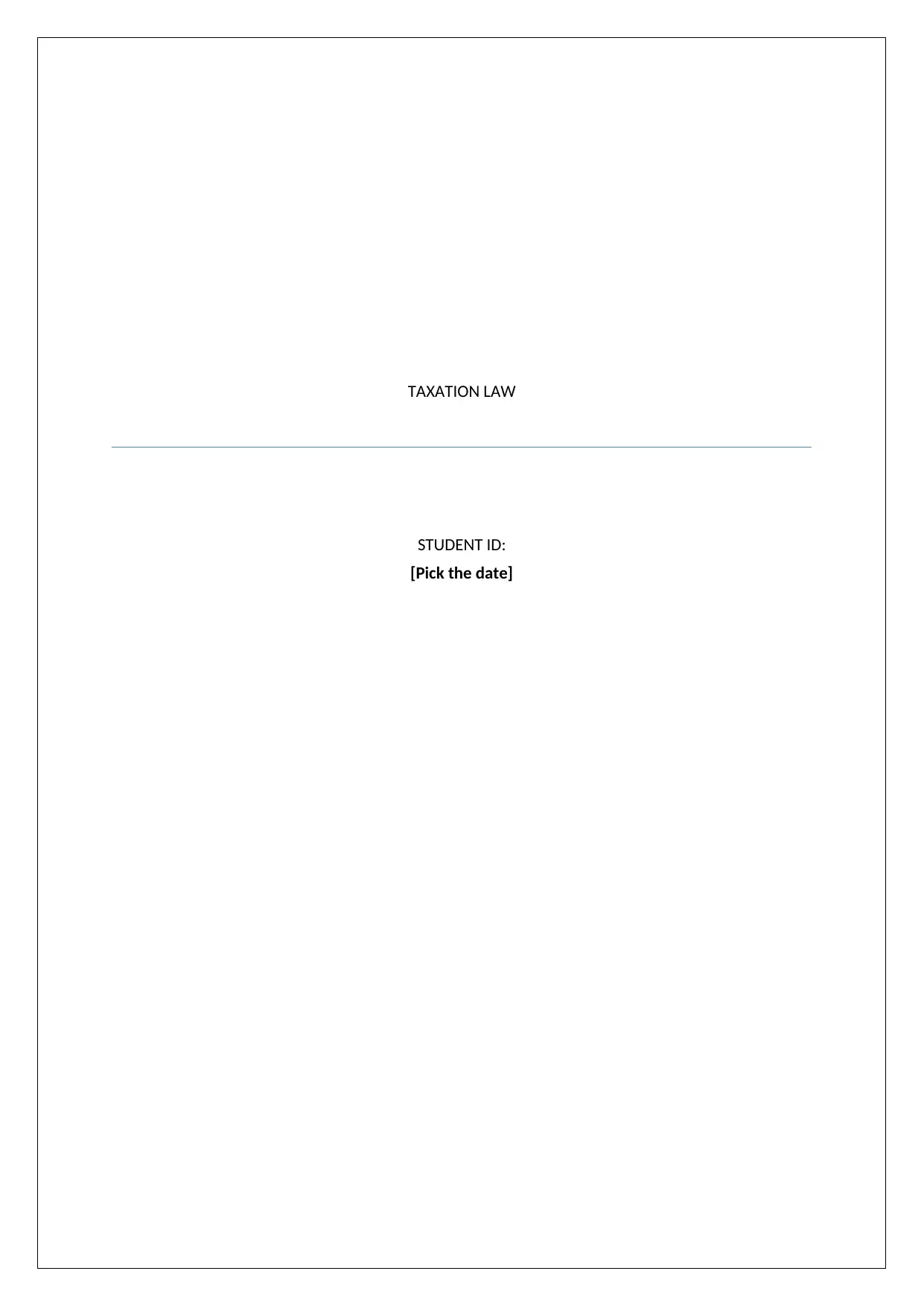
TAXATION LAW
STUDENT ID:
[Pick the date]
STUDENT ID:
[Pick the date]
Paraphrase This Document
Need a fresh take? Get an instant paraphrase of this document with our AI Paraphraser
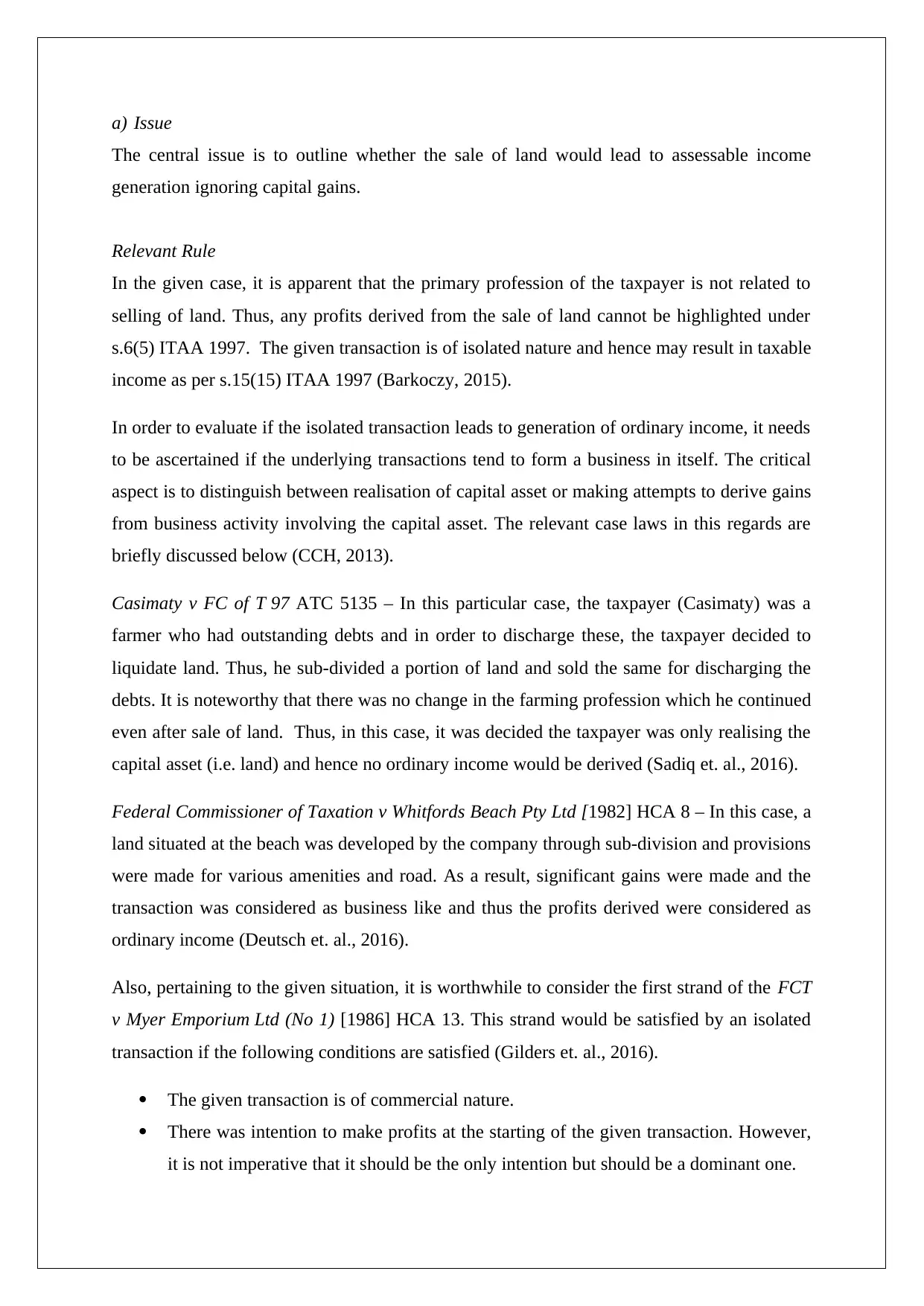
a) Issue
The central issue is to outline whether the sale of land would lead to assessable income
generation ignoring capital gains.
Relevant Rule
In the given case, it is apparent that the primary profession of the taxpayer is not related to
selling of land. Thus, any profits derived from the sale of land cannot be highlighted under
s.6(5) ITAA 1997. The given transaction is of isolated nature and hence may result in taxable
income as per s.15(15) ITAA 1997 (Barkoczy, 2015).
In order to evaluate if the isolated transaction leads to generation of ordinary income, it needs
to be ascertained if the underlying transactions tend to form a business in itself. The critical
aspect is to distinguish between realisation of capital asset or making attempts to derive gains
from business activity involving the capital asset. The relevant case laws in this regards are
briefly discussed below (CCH, 2013).
Casimaty v FC of T 97 ATC 5135 – In this particular case, the taxpayer (Casimaty) was a
farmer who had outstanding debts and in order to discharge these, the taxpayer decided to
liquidate land. Thus, he sub-divided a portion of land and sold the same for discharging the
debts. It is noteworthy that there was no change in the farming profession which he continued
even after sale of land. Thus, in this case, it was decided the taxpayer was only realising the
capital asset (i.e. land) and hence no ordinary income would be derived (Sadiq et. al., 2016).
Federal Commissioner of Taxation v Whitfords Beach Pty Ltd [1982] HCA 8 – In this case, a
land situated at the beach was developed by the company through sub-division and provisions
were made for various amenities and road. As a result, significant gains were made and the
transaction was considered as business like and thus the profits derived were considered as
ordinary income (Deutsch et. al., 2016).
Also, pertaining to the given situation, it is worthwhile to consider the first strand of the FCT
v Myer Emporium Ltd (No 1) [1986] HCA 13. This strand would be satisfied by an isolated
transaction if the following conditions are satisfied (Gilders et. al., 2016).
The given transaction is of commercial nature.
There was intention to make profits at the starting of the given transaction. However,
it is not imperative that it should be the only intention but should be a dominant one.
The central issue is to outline whether the sale of land would lead to assessable income
generation ignoring capital gains.
Relevant Rule
In the given case, it is apparent that the primary profession of the taxpayer is not related to
selling of land. Thus, any profits derived from the sale of land cannot be highlighted under
s.6(5) ITAA 1997. The given transaction is of isolated nature and hence may result in taxable
income as per s.15(15) ITAA 1997 (Barkoczy, 2015).
In order to evaluate if the isolated transaction leads to generation of ordinary income, it needs
to be ascertained if the underlying transactions tend to form a business in itself. The critical
aspect is to distinguish between realisation of capital asset or making attempts to derive gains
from business activity involving the capital asset. The relevant case laws in this regards are
briefly discussed below (CCH, 2013).
Casimaty v FC of T 97 ATC 5135 – In this particular case, the taxpayer (Casimaty) was a
farmer who had outstanding debts and in order to discharge these, the taxpayer decided to
liquidate land. Thus, he sub-divided a portion of land and sold the same for discharging the
debts. It is noteworthy that there was no change in the farming profession which he continued
even after sale of land. Thus, in this case, it was decided the taxpayer was only realising the
capital asset (i.e. land) and hence no ordinary income would be derived (Sadiq et. al., 2016).
Federal Commissioner of Taxation v Whitfords Beach Pty Ltd [1982] HCA 8 – In this case, a
land situated at the beach was developed by the company through sub-division and provisions
were made for various amenities and road. As a result, significant gains were made and the
transaction was considered as business like and thus the profits derived were considered as
ordinary income (Deutsch et. al., 2016).
Also, pertaining to the given situation, it is worthwhile to consider the first strand of the FCT
v Myer Emporium Ltd (No 1) [1986] HCA 13. This strand would be satisfied by an isolated
transaction if the following conditions are satisfied (Gilders et. al., 2016).
The given transaction is of commercial nature.
There was intention to make profits at the starting of the given transaction. However,
it is not imperative that it should be the only intention but should be a dominant one.
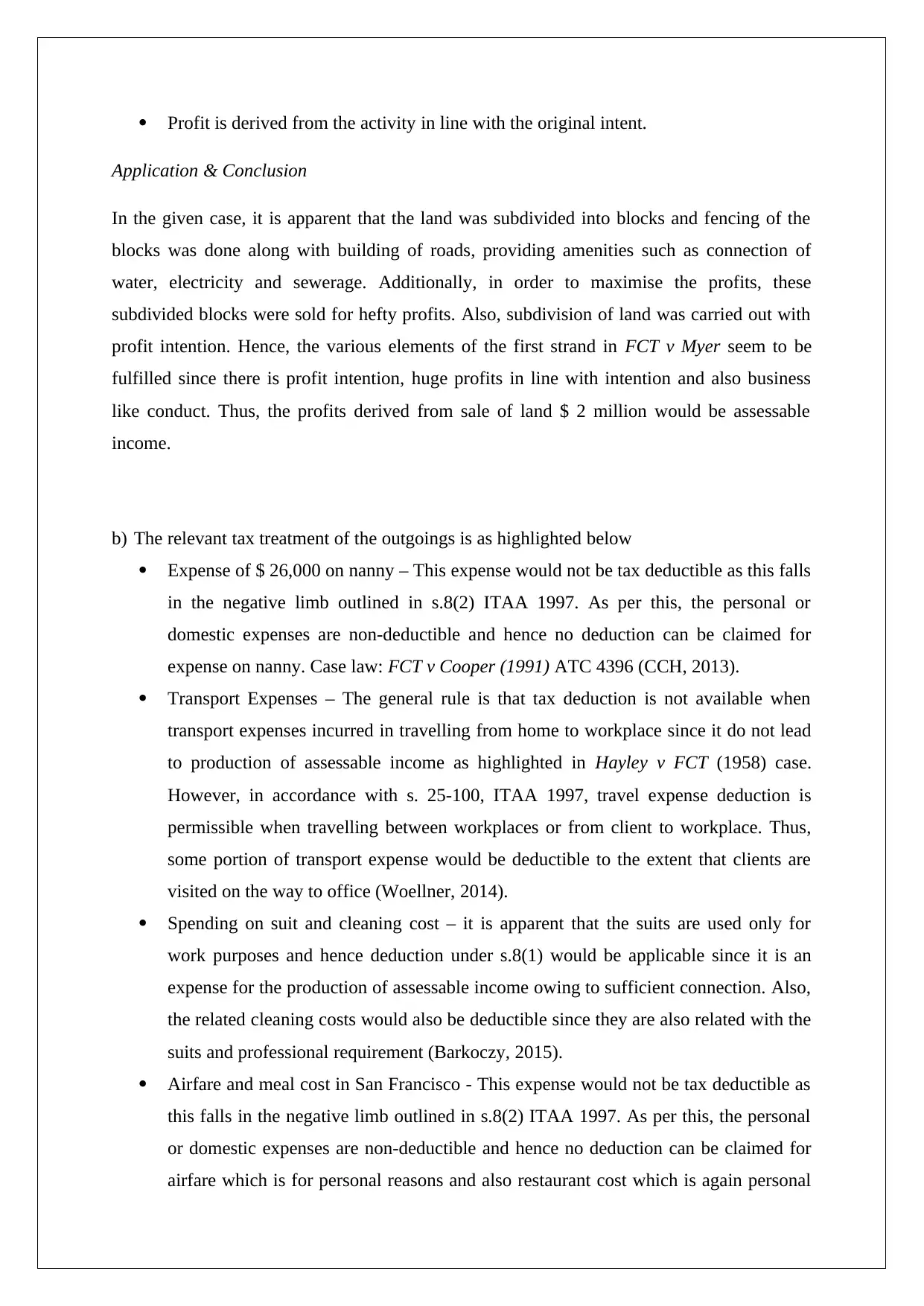
Profit is derived from the activity in line with the original intent.
Application & Conclusion
In the given case, it is apparent that the land was subdivided into blocks and fencing of the
blocks was done along with building of roads, providing amenities such as connection of
water, electricity and sewerage. Additionally, in order to maximise the profits, these
subdivided blocks were sold for hefty profits. Also, subdivision of land was carried out with
profit intention. Hence, the various elements of the first strand in FCT v Myer seem to be
fulfilled since there is profit intention, huge profits in line with intention and also business
like conduct. Thus, the profits derived from sale of land $ 2 million would be assessable
income.
b) The relevant tax treatment of the outgoings is as highlighted below
Expense of $ 26,000 on nanny – This expense would not be tax deductible as this falls
in the negative limb outlined in s.8(2) ITAA 1997. As per this, the personal or
domestic expenses are non-deductible and hence no deduction can be claimed for
expense on nanny. Case law: FCT v Cooper (1991) ATC 4396 (CCH, 2013).
Transport Expenses – The general rule is that tax deduction is not available when
transport expenses incurred in travelling from home to workplace since it do not lead
to production of assessable income as highlighted in Hayley v FCT (1958) case.
However, in accordance with s. 25-100, ITAA 1997, travel expense deduction is
permissible when travelling between workplaces or from client to workplace. Thus,
some portion of transport expense would be deductible to the extent that clients are
visited on the way to office (Woellner, 2014).
Spending on suit and cleaning cost – it is apparent that the suits are used only for
work purposes and hence deduction under s.8(1) would be applicable since it is an
expense for the production of assessable income owing to sufficient connection. Also,
the related cleaning costs would also be deductible since they are also related with the
suits and professional requirement (Barkoczy, 2015).
Airfare and meal cost in San Francisco - This expense would not be tax deductible as
this falls in the negative limb outlined in s.8(2) ITAA 1997. As per this, the personal
or domestic expenses are non-deductible and hence no deduction can be claimed for
airfare which is for personal reasons and also restaurant cost which is again personal
Application & Conclusion
In the given case, it is apparent that the land was subdivided into blocks and fencing of the
blocks was done along with building of roads, providing amenities such as connection of
water, electricity and sewerage. Additionally, in order to maximise the profits, these
subdivided blocks were sold for hefty profits. Also, subdivision of land was carried out with
profit intention. Hence, the various elements of the first strand in FCT v Myer seem to be
fulfilled since there is profit intention, huge profits in line with intention and also business
like conduct. Thus, the profits derived from sale of land $ 2 million would be assessable
income.
b) The relevant tax treatment of the outgoings is as highlighted below
Expense of $ 26,000 on nanny – This expense would not be tax deductible as this falls
in the negative limb outlined in s.8(2) ITAA 1997. As per this, the personal or
domestic expenses are non-deductible and hence no deduction can be claimed for
expense on nanny. Case law: FCT v Cooper (1991) ATC 4396 (CCH, 2013).
Transport Expenses – The general rule is that tax deduction is not available when
transport expenses incurred in travelling from home to workplace since it do not lead
to production of assessable income as highlighted in Hayley v FCT (1958) case.
However, in accordance with s. 25-100, ITAA 1997, travel expense deduction is
permissible when travelling between workplaces or from client to workplace. Thus,
some portion of transport expense would be deductible to the extent that clients are
visited on the way to office (Woellner, 2014).
Spending on suit and cleaning cost – it is apparent that the suits are used only for
work purposes and hence deduction under s.8(1) would be applicable since it is an
expense for the production of assessable income owing to sufficient connection. Also,
the related cleaning costs would also be deductible since they are also related with the
suits and professional requirement (Barkoczy, 2015).
Airfare and meal cost in San Francisco - This expense would not be tax deductible as
this falls in the negative limb outlined in s.8(2) ITAA 1997. As per this, the personal
or domestic expenses are non-deductible and hence no deduction can be claimed for
airfare which is for personal reasons and also restaurant cost which is again personal
⊘ This is a preview!⊘
Do you want full access?
Subscribe today to unlock all pages.

Trusted by 1+ million students worldwide
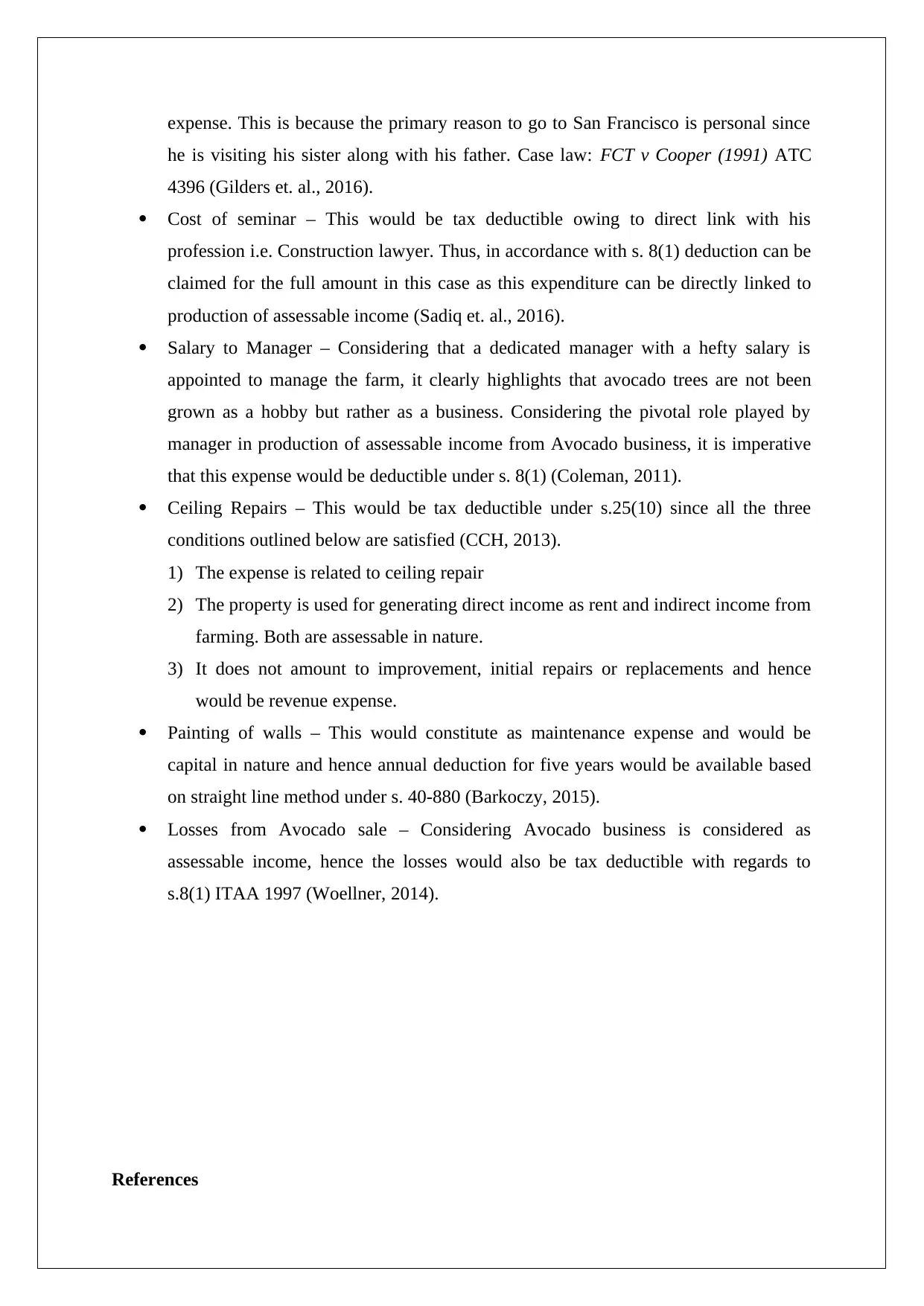
expense. This is because the primary reason to go to San Francisco is personal since
he is visiting his sister along with his father. Case law: FCT v Cooper (1991) ATC
4396 (Gilders et. al., 2016).
Cost of seminar – This would be tax deductible owing to direct link with his
profession i.e. Construction lawyer. Thus, in accordance with s. 8(1) deduction can be
claimed for the full amount in this case as this expenditure can be directly linked to
production of assessable income (Sadiq et. al., 2016).
Salary to Manager – Considering that a dedicated manager with a hefty salary is
appointed to manage the farm, it clearly highlights that avocado trees are not been
grown as a hobby but rather as a business. Considering the pivotal role played by
manager in production of assessable income from Avocado business, it is imperative
that this expense would be deductible under s. 8(1) (Coleman, 2011).
Ceiling Repairs – This would be tax deductible under s.25(10) since all the three
conditions outlined below are satisfied (CCH, 2013).
1) The expense is related to ceiling repair
2) The property is used for generating direct income as rent and indirect income from
farming. Both are assessable in nature.
3) It does not amount to improvement, initial repairs or replacements and hence
would be revenue expense.
Painting of walls – This would constitute as maintenance expense and would be
capital in nature and hence annual deduction for five years would be available based
on straight line method under s. 40-880 (Barkoczy, 2015).
Losses from Avocado sale – Considering Avocado business is considered as
assessable income, hence the losses would also be tax deductible with regards to
s.8(1) ITAA 1997 (Woellner, 2014).
References
he is visiting his sister along with his father. Case law: FCT v Cooper (1991) ATC
4396 (Gilders et. al., 2016).
Cost of seminar – This would be tax deductible owing to direct link with his
profession i.e. Construction lawyer. Thus, in accordance with s. 8(1) deduction can be
claimed for the full amount in this case as this expenditure can be directly linked to
production of assessable income (Sadiq et. al., 2016).
Salary to Manager – Considering that a dedicated manager with a hefty salary is
appointed to manage the farm, it clearly highlights that avocado trees are not been
grown as a hobby but rather as a business. Considering the pivotal role played by
manager in production of assessable income from Avocado business, it is imperative
that this expense would be deductible under s. 8(1) (Coleman, 2011).
Ceiling Repairs – This would be tax deductible under s.25(10) since all the three
conditions outlined below are satisfied (CCH, 2013).
1) The expense is related to ceiling repair
2) The property is used for generating direct income as rent and indirect income from
farming. Both are assessable in nature.
3) It does not amount to improvement, initial repairs or replacements and hence
would be revenue expense.
Painting of walls – This would constitute as maintenance expense and would be
capital in nature and hence annual deduction for five years would be available based
on straight line method under s. 40-880 (Barkoczy, 2015).
Losses from Avocado sale – Considering Avocado business is considered as
assessable income, hence the losses would also be tax deductible with regards to
s.8(1) ITAA 1997 (Woellner, 2014).
References
Paraphrase This Document
Need a fresh take? Get an instant paraphrase of this document with our AI Paraphraser
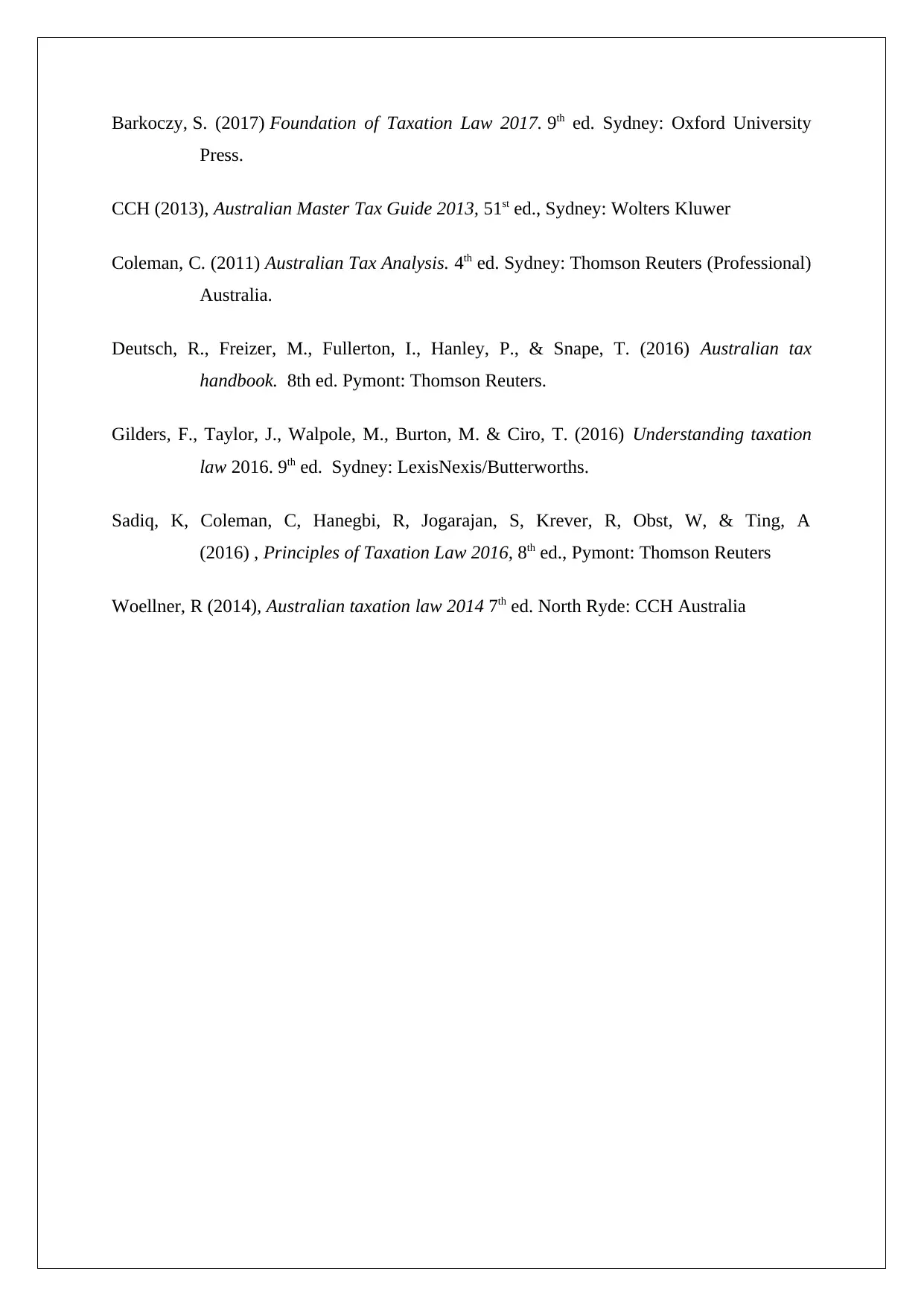
Barkoczy, S. (2017) Foundation of Taxation Law 2017. 9th ed. Sydney: Oxford University
Press.
CCH (2013), Australian Master Tax Guide 2013, 51st ed., Sydney: Wolters Kluwer
Coleman, C. (2011) Australian Tax Analysis. 4th ed. Sydney: Thomson Reuters (Professional)
Australia.
Deutsch, R., Freizer, M., Fullerton, I., Hanley, P., & Snape, T. (2016) Australian tax
handbook. 8th ed. Pymont: Thomson Reuters.
Gilders, F., Taylor, J., Walpole, M., Burton, M. & Ciro, T. (2016) Understanding taxation
law 2016. 9th ed. Sydney: LexisNexis/Butterworths.
Sadiq, K, Coleman, C, Hanegbi, R, Jogarajan, S, Krever, R, Obst, W, & Ting, A
(2016) , Principles of Taxation Law 2016, 8th ed., Pymont: Thomson Reuters
Woellner, R (2014), Australian taxation law 2014 7th ed. North Ryde: CCH Australia
Press.
CCH (2013), Australian Master Tax Guide 2013, 51st ed., Sydney: Wolters Kluwer
Coleman, C. (2011) Australian Tax Analysis. 4th ed. Sydney: Thomson Reuters (Professional)
Australia.
Deutsch, R., Freizer, M., Fullerton, I., Hanley, P., & Snape, T. (2016) Australian tax
handbook. 8th ed. Pymont: Thomson Reuters.
Gilders, F., Taylor, J., Walpole, M., Burton, M. & Ciro, T. (2016) Understanding taxation
law 2016. 9th ed. Sydney: LexisNexis/Butterworths.
Sadiq, K, Coleman, C, Hanegbi, R, Jogarajan, S, Krever, R, Obst, W, & Ting, A
(2016) , Principles of Taxation Law 2016, 8th ed., Pymont: Thomson Reuters
Woellner, R (2014), Australian taxation law 2014 7th ed. North Ryde: CCH Australia
1 out of 5
Related Documents
Your All-in-One AI-Powered Toolkit for Academic Success.
+13062052269
info@desklib.com
Available 24*7 on WhatsApp / Email
![[object Object]](/_next/static/media/star-bottom.7253800d.svg)
Unlock your academic potential
Copyright © 2020–2025 A2Z Services. All Rights Reserved. Developed and managed by ZUCOL.





